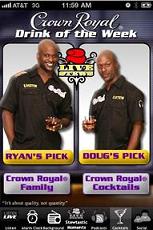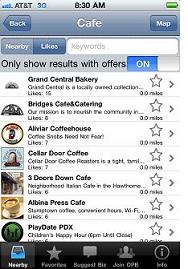jacAPPS head honcho and sales maven, Paul Jacobs, takes a closer look at all the hubbub surrounding Facebook, and what the mobile future holds for radio.
With all the attention circulating around Facebook’s IPO disclosure, this quote was “best in show” in our opinion:
We all know that radio, like many other industries, has struggled in the area of monetizing its digital platforms. CPM’s are lower than over-the-air advertising, sellers aren’t well-trained, and even the agencies have trouble figuring out how to make the various channels work.
But this admission got my attention because it’s not from a radio CEO – it’s from Facebook’s IPO filing with the Securities and Exchange Commission.
So what gives here? Mobile advertising is exploding and Facebook’s got 425 MILLION monthly mobile users – and they haven’t figured out how to monetize it? And this may turn out to be a $100 billion company!
 Maybe Facebook can take a lesson in mobile revenue generation from good old radio. While it’s still the second inning, our jacAPPS division has seen numerous examples of radio successfully leveraging mobile platforms, sales infrastructure, and relationships to make money. An increasing number of avails are coming with mobile requests, and radio has done a better-than-average job of responding. While it’s not going to enable radio to blow through its sales goals, it’s the beginning of a mobile revenue stream.
Maybe Facebook can take a lesson in mobile revenue generation from good old radio. While it’s still the second inning, our jacAPPS division has seen numerous examples of radio successfully leveraging mobile platforms, sales infrastructure, and relationships to make money. An increasing number of avails are coming with mobile requests, and radio has done a better-than-average job of responding. While it’s not going to enable radio to blow through its sales goals, it’s the beginning of a mobile revenue stream.
What’s impressive about radio’s initial success in this space is that it is coming from a wide variety of sources and solutions. Pre-roll advertising, in-app streaming ads with graphics, and display ads provide a baseline revenue source for radio stations. We’re well-structured to sell these platforms because they parallel our traditional spot-selling strategies.
The better news is that we’re beginning to see radio stretch itself and provide higher level – and higher dollar – mobile solutions for its advertisers. Last fall, Entercom stations in Seattle and Portland (see above) sold a creative and multi-channel mobile promotion to Papa John’s, enabling listeners to order pizza directly through their smartphones. It generated a significant amount of new digital revenue and it works on all levels – there’s a great listener benefit that takes advantage of the smartphone’s assets, it’s additive to the app, and the stations involved got a huge revenue shot.
The 2 Live Stews in Atlanta do a weekly feature called “Cocktail of the Week.” By partnering with Crown Royal, the station got a significant buy and took the concept to mobile, providing drink recipes. It’s a great example of “pinballing” – taking an on-air feature, driving listeners to the mobile app, and providing a great benefit for them.
And coming out next month is a platform created Publink from friends of ours in public radio (see below). It will be rolled out to public and commercial radio in the next month or so, and is a scalable and robust combination of Groupon and AroundMe. It’s great because it enables local stations to penetrate businesses that aren’t typically on the radio (either because of lack of budget or desire or both) by providing coupons that can be changed remotely by the business and appear in the app. Features include geo-location, social sharing, and other key elements that we believe will become a major new revenue source for radio. And these types apps allow the industry to better compete with national sites like Groupon and Living Social.
 And radio isn’t done yet. I’m spending more time than ever talking to jacAPPS clients about new revenue generation ideas, such as entertainment guides, ski condition apps, festival and concert apps, and other ways of not only connecting with listener communities in the mobile space, but generating sponsorship revenue at the same time.
And radio isn’t done yet. I’m spending more time than ever talking to jacAPPS clients about new revenue generation ideas, such as entertainment guides, ski condition apps, festival and concert apps, and other ways of not only connecting with listener communities in the mobile space, but generating sponsorship revenue at the same time.
The NAB recognizes this opportunity, too. I’ll be on a panel on this topic at their April convention in Vegas. The mobile future for radio is bright.
So I don’t know what’s taken Facebook so long to monetize mobile. They may be the smartest guys in the room, but even they admit they’ve been stymied by the ability to generate revenue in this dynamic space. And while radio hasn’t totally figured it out (frankly, we’ve just scratched the surface), we may actually be further along than the hottest story on Wall Street.
But that won’t last long. Radio needs to dedicate research, development, and expertise to identifying the best sales structure that can generate mobile revenue. Do we train traditional sellers or hire dedicated specialists (I lean toward the latter)? The industry needs to conduct usability and audience testing to determine the optimal approach to not only the design of station apps, but these other platform opportunities as well.
What does the mobile consumer want, and how can radio best give it to her?
 Radio is perfectly suited for a happy mobile revenue future at a time when its meat and potato inventory is not as in vogue as it once was. Agencies want integrated packages, or marketing opportunities that combine the best of mobile and social.
Radio is perfectly suited for a happy mobile revenue future at a time when its meat and potato inventory is not as in vogue as it once was. Agencies want integrated packages, or marketing opportunities that combine the best of mobile and social.
Yet, radio has it all – cume, brand image, awareness, local knowledge and presence, focused target lifegroups, and a sales infrastructure that can be re-aligned and re-focused. Radio stations have deep contacts at ad agencies and with local businesses. Companies like Groupon, Facebook, and even Pandora are essentially starting from scratch. But they’re moving quickly.
Radio needs to enhance its advantages as much as it needs to embrace change. The industry has proven that it is more successful – even at this early stage – at generating mobile revenue than even Facebook. But not for long.
Mobile is the future for Facebook. And radio.
- For Radio, Will It Be Christmas In April (And Hopefully, May)? - April 21, 2025
- The Revolution Will Not Be Monetized - December 30, 2024
- What Kind Of Team Do You Want To Be? - October 4, 2024





Publink is an ingenious integration but it raises more questions than it answers:
Does it require the user to install a new app?
Or is it integrated into a new version of the station’s existing app?
Assuming the user friction is acceptable, what’s the real world revenue potential for stations of another coupon service at a time when Groupon’s competitors are proliferating and some of the steam is already leaking out of the discount trend?
Do add-ons like Publink that extend and complicate the advertising platform for public media add significant value to the core audio services of the station?
Publink is scalable in theory, but is it extensible over time?
:: Stephen Hill
Stephen,
Great questions. Let me try to tackle them.
We can add Publink to an existing app or build a separate one based on a station’s strategy.
While there’s no question that Groupon is formidable, radio stations serve a defined lifegroup, so unlike Groupon (which keeps sending me couupons for manicures) the offers can be much better targeted. Plus, radio has something that Groupon can’t match . . . cume, and a megaphone to reach them.
I don’t have an answer to your final question. It’s too early. But let’s face it, this makes a lot of sense.
Call me if you want to discuss further.